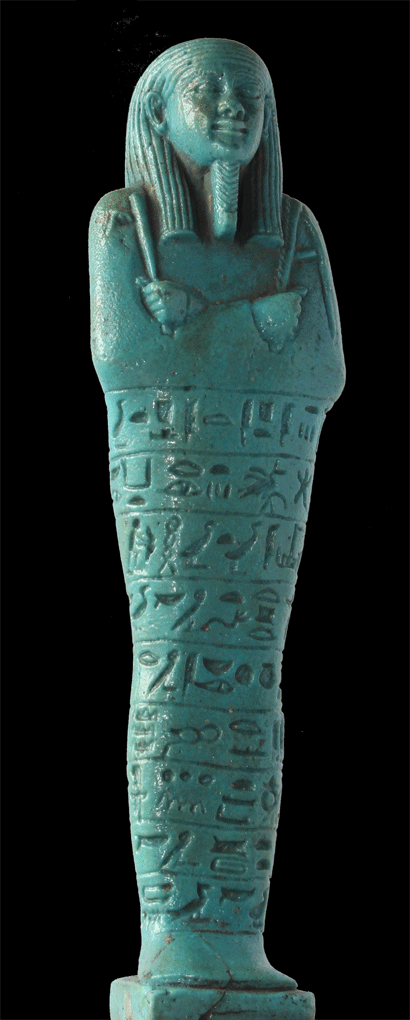|
|
|||||||
|
|
|
|
|
|
|
|
|
|
|
|||||||||||
|
|
|
|
|
|
|
|
|
|
|
|
|
|
|
||
|
|
|
|
|
|
||||||||||||||||||||||||||||||||||||||||||||||
|
Late Period
In the Late Period funerary statuettes became known as ‘ushabtis’ which translates as ‘answerers.’ They were only made in faience that would have been glazed blue, but as noted
earlier in this brief overview, the colour of the glaze has often discoloured
to shades of green or turquoise.
A hoe and a pick are now detailed in the modelling being carried in the hands
together with the cord or rope for a basket that is carried behind the left or
right shoulder because of another feature that appears on ushabtis in the Late
Period - the dorsal or back pillar. The ushabtis also stand upon a trapezoidal
base [150] - [152].
The pillar and base are inspired by statuary and coffins of the period. The
ushabtis were made in two–piece pottery moulds with the inscription nearly always being incised and
usually tidied up with a finely pointed tool prior to firing. As well as the
title(s) of the owner, the mother or father’s name is very often written on Late Period ushabtis. These figures are often
inscribed with Chapter 6 of the Book of the Dead, especially the larger
ushabtis.
The prerequisite number of ushabtis continued to be 401. Many were very
carefully modelled, and some are real masterpieces of faience manufacture [153] - 155].
Although the earlier type of ‘overseer’ figure wearing the kilt of everyday life and carrying a whip is not found
beyond the Third Intermediate Period it has been suggested that the two types, ‘overseers’ and ‘workers’, are differentiated in the Late Period by their inscriptions. For example, a
Chancellor of the King of Lower Egypt called Horudja who was born to
Iset-en-Mehyt had two types of ushabtis, large ones inscribed with Chapter 6 of
the Book of the Dead (see [154]), and smaller ones with a ‘T’–shaped inscription that are far more numerous - there are 144 in Naples for
example with many more known in other collections
[156]. This suggests that the large figures are potentially ‘overseers,’ with the smaller ones being workers. However, both types carry a pick, a hoe
and a basket. Indeed, it was fairly common in the Late period for owners to
have two types of ushabtis. As a matter of interest, a well–known group of ushabtis for another owner who was God’s Servant of Neith, Horudja from Hawara shows no such variety (see [150]) . His
ushabtis, which number 399, are all large and inscribed with Chapter 6 of the
Book of the Dead with no obvious differentiation to suggest that any of them
are ‘overseers.’ Another possibility by way of identifying potential ‘overseers’ is within groups in which large numbers of ushabtis are uninscribed, with fewer
examples being found with an inscription suggesting that they could be
potentially be 'overseers'
[157]. This is an area that needs further research.
Kings of the Late Period had ushabtis. The early ones, for example Psamtek I,
Necho II and Apries, wear a nemes headcloth with a uraeus at the front [158]-[160], but from those known for Amasis III and later wear a tripartite wig without a
uraeus [161]-[164]. An ushabti known for Nectanebo II is extremely finely modelled and has a
wonderful blue glaze and it is, at the moment, the last royal example known.
|
|
|||||||||||||||||||||||||||||||||||||||||||||
|
Select any group to enlarge
|
|
|||||||||||||||||||||||||||||||||||||||||||||
|
|
||||||||||||||||||||||||||||||||||||||||||||||
|
|
||||||||||||||||||||||||||||||||||||||||||||||
|
|
||||||||||||||||||||||||||||||||||||||||||||||
|
[150]
|
[151]
|
[152]
|
|
|||||||||||||||||||||||||||||||||||||||||||
|
|
||||||||||||||||||||||||||||||||||||||||||||||
|
|
||||||||||||||||||||||||||||||||||||||||||||||
|
|
||||||||||||||||||||||||||||||||||||||||||||||
|
|
||||||||||||||||||||||||||||||||||||||||||||||
|
[153]
|
[154]
|
[155]
|
|
|||||||||||||||||||||||||||||||||||||||||||
|
|
||||||||||||||||||||||||||||||||||||||||||||||
|
|
||||||||||||||||||||||||||||||||||||||||||||||
|
|
||||||||||||||||||||||||||||||||||||||||||||||
|
[156]
|
|
|||||||||||||||||||||||||||||||||||||||||||||
|
|
||||||||||||||||||||||||||||||||||||||||||||||
|
|
||||||||||||||||||||||||||||||||||||||||||||||
|
|
||||||||||||||||||||||||||||||||||||||||||||||
|
|
||||||||||||||||||||||||||||||||||||||||||||||
|
[157]
|
|
|||||||||||||||||||||||||||||||||||||||||||||
|
|
||||||||||||||||||||||||||||||||||||||||||||||
|
|
||||||||||||||||||||||||||||||||||||||||||||||
|
|
||||||||||||||||||||||||||||||||||||||||||||||
|
[158]
|
[159]
|
[160]
|
[161]
|
[162]
|
[163]
|
[164]
|
|
|||||||||||||||||||||||||||||||||||||||
|
|
||||||||||||||||||||||||||||||||||||||||||||||
|
|
||||||||||||||||||||||||||||||||||||||||||||||
|
[150] Horudja (Manchester, MM 3724)
[151] PadiNeith (Liverpool, WM 49.8.33)
[152] Horiraa (Manchester, MM 9432)
[153] Psamtek (Liverpool, WM 56.21.99)
[154] Horudja (Collection A)
[155] NeferibresaNeith (Getty Museum, 2016.2)
[156] Ushabtis for Horudja in Naples (courtesy of DvB)
[157] Ushabtis for Pesjenretekem(?) (a selection from Swansea, EC; Boston, MFA; London, BM)
[158] Psamtek I(?) (London, BM EA 21922)
[159] Necho II (Leiden, RMO F 1988/7.1)
[160] Apries (Art market, New York)
[161] Amasis III (Collection A)
[162] Nepherites I (Collection K)
[163] Hakoris (Paris, Louvre E25981)
[164] Nectanebo II (Turin, ME 2509 RCGE 19971)
|
|
|||||||||||||||||||||||||||||||||||||||||||||
|
|
|
|
|
|
|
|
|
|
|
|
|
|
|
|
|
|
|
|
|
|
|
|
|
|
|
|
|
|
|
|
|
|
|
|
|
|
|
|
|
|
|
|
|
|
|
|
